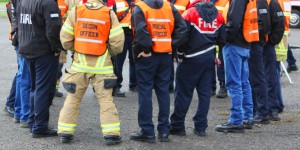By Leischen Stelter
During his 30-year career as a firefighter, George Munkenbeck has been involved in many disaster response and recovery efforts. But when Superstorm Sandy hit his hometown of West Sayville, N.Y. in October 2012, the flooding was far beyond anything he had seen in his fire district and in the surrounding areas.
In addition to a long career in fire services (he served as a captain with the West Sayville Fire Department and now serves as chaplain), Munkenbeck is also a professor at American Military University, teaching courses in fire, emergency and disaster management, and homeland security for more than 12 years.

Munkenbeck is part of The New York Rising Community Reconstruction Program and is the representative for the fire department for the hamlets of Oakdale and West Sayville.
“This committee is made up of representatives from town government like city planners and emergency managers, as well as local citizens,” he said. “We come together and work to come up with ideas. Slowly but surely we’re figuring out what the big items are that this hamlet needs to survive,” he said.
Even though Munkenbeck says there are a lot of things New York could have done better in terms of response and recovery to Sandy, he commends the state for turning to individual communities to determine their own recovery needs. “New York recognizes that it has strong local governments and it is trying to build on that,” he said.
“This is probably the best system I’ve seen for recovery efforts because the state isn’t coming down and telling the communities what to do,” he said. Instead, the state has promised each recovery area $3 million dollars, with the potential for more assistance for things that might be needed, but may not fall under Sandy recovery funding.
This program has allowed individual committees to come up with and prioritize recovery projects in their communities. To aid in this planning process, the program has provided service professionals, like city planners and assessors, to be resources during these planning phases, but the project ideas remain in the hands of those in the community.
In addition, the state has provided multiple training opportunities. For example, Munkenbeck recently attended the state’s new citizen involvement effort, NYS Prepare. This initiative is similar in concept to a Community Emergency Response Team (CERT), but it is aimed at a larger base with the intention of making each citizen prepared for survival.
While it is still in the early stages, the goal of this program is to share basic preparedness skills and information with the citizens. It is taught by the National Guard and includes the concept of the “go bag” as well as other information that citizens need to know to be ready to sustain life for the initial period following a disaster.
After Superstorm Sandy hit, many communities were without power for a significant period of time. People in New York City who lived in high-rise apartments, for instance, had no elevators and for those who were handicapped and/or elderly, it was very difficult to get groceries and water to them. In areas such as the West Sayville–Oakdale Fire District, there was no gasoline or refrigeration, food stocks were low, and roads blocked for a few days. Therefore, basic preparation skills are necessary to insure that the citizens are ready and prepared for such emergencies.
“I think this [approach to preparation and recovery] is the way to go,” Munkenbeck said. “The old top-down approach has never worked and if we look at the history of successful recovery efforts, it always comes from areas that are able to recover by themselves.”
Comments are closed.